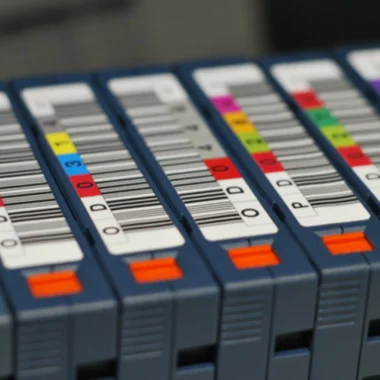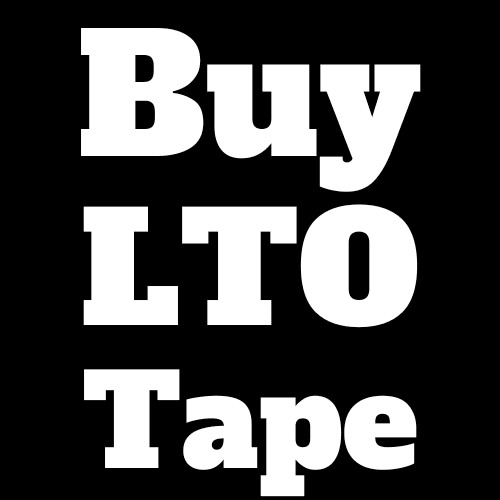Linear Tape-Open (LTO) is a widely adopted magnetic tape format used for data storage across various industries. Known for its impressive storage capacity, LTO has become the leading tape-based solution for large-scale data archiving. The latest version, LTO-9, can hold up to 18 terabytes of data on a single tape, making it one of the most efficient storage mediums available. In addition to its massive capacity, LTO is highly scalable and flexible, making it suitable for both small businesses and large enterprises.
In this guide, we’ll explore everything you need to know about LTO tapes, including:
- What LTO is and how it works
- The history of the LTO format
- Technical specifications of LTO tapes
- Key benefits and practical applications of LTO storage
- And much more
Let’s start with the basics—what exactly is LTO?
What Is LTO?
LTO, short for Linear Tape-Open, is a magnetic tape-based storage technology first introduced in the late 1990s. It was developed through a collaboration between IBM, HP, and Seagate, collectively known as the LTO Consortium. Designed as an open standard, LTO is primarily available in the Ultrium format, which features a half-inch single-reel tape designed for high-capacity storage.
While LTO itself is relatively modern, magnetic tape storage has been around since the 1950s. Early formats, such as IBM’s 7-track and 9-track tapes, laid the groundwork for data tape technology. By the late 1990s, Quantum’s Digital Linear Tape (DLT) and Sony’s Advanced Intelligent Tape (AIT) dominated the market for high-capacity data storage in enterprise environments. However, both technologies were proprietary, limiting competition and keeping costs high.
To address these market limitations, IBM, HP, and Seagate established the LTO Consortium, aiming to create an alternative that would introduce more competition and innovation. Their initial plan involved two formats: Ultrium, a high-capacity half-inch single-reel tape, and Accelis, an 8mm dual-reel tape optimized for speed and low latency. However, only Ultrium was ever released to the public.
Since its introduction, LTO Ultrium has become the industry standard for long-term data storage and archiving. The first-generation LTO tape, released in 2000, offered a native storage capacity of 100 GB. Originally, lower-capacity versions (10 GB, 30 GB, and 50 GB) were planned, but they were ultimately abandoned in favor of the high-capacity Ultrium format.
LTO Generations
As of 2021, nine generations of LTO Ultrium tapes (LTO-1 through LTO-9) have been released, with additional versions (LTO-10 through LTO-14) planned for future development. Each new generation introduces higher storage capacities, faster data transfer speeds, and improved security features.
Below, we’ll take a closer look at the specifications of each LTO generation and how they compare:
| Format | Release Date | Uncompressed Capacity | Compressed Capacity | Max Compressed Speed (MB/s) | Max Uncommpressed Speed (MB/s) | Time needed to write a full tape at maximum speed (hh:mm) |
| LTO-1 | 2000 | 100 GB | 200 GB | 20 | 40 | 1:23 |
| LTO-2 | 2003 | 200 GB | 400 GB | 40 | 80 | 1:23 |
| LTO-3 | 2005 | 400 GB | 800 GB | 80 | 160 | 1:23 |
| LTO-4 | 2007 | 800 GB | 1.6 TB | 120 | 240 | 1:51 |
| LTO-5 | 2010 | 1.5 TB | 3.0 TB | 140 | 280 | 3:10 |
| LTO-6 | 2012 | 2.5 TB | 6.25 TB | 160 | 400 | 4:20 |
| LTO-7 | 2015 | 6.0 TB | 15.0 TB | 300 | 750 | 5:33 |
| Type M (M8) | 2017 | 9.0 TB | 22.5 TB | 300 | 750 | 8:20 |
| LTO-8 | 2017 | 12.0 TB | 30.0 TB | 360 | 900 | 9:16 |
| LTO-9 | 2021 | 18.0 TB | 45.0 TB | 400 | 1,000 | 12:30 |
| LTO-10 | TBA | 36.0 TB | 90.0 TB | 1,100 | 2,750 | 12:07 |
| LTO-11 | TBA | 72.0 TB | 180.0 TB | TBA | TBA | TBA |
| LTO-12 | TBA | 144.0 TB | 360.0 TB | TBA | TBA | TBA |
| LTO-13 | TBA | 288.0 TB | 720.0 TB | TBA | TBA | TBA |
| LTO-14 | TBA | 576.0 TB | 1,440 TB | TBA | TBA | TBA |
Understanding LTO Tape Compatibility and Functionality
What Is Type M (M8)?
The term Type M (M8) refers to a feature in some LTO-8 drives that allows them to write to previously unused LTO-7 tapes with an increased native capacity of 9 TB. However, once a tape is initialized as Type M, it cannot be reverted to a standard LTO-7 cartridge.
LTO Drive Compatibility Rules
Unlike some other tape storage technologies, LTO Ultrium cartridges are only compatible with specific generations of LTO drives. The compatibility follows these general rules:
- LTO drives up to and including LTO-7 can read data from cartridges up to two generations prior (e.g., an LTO-7 drive can read LTO-6 and LTO-5 tapes, but not LTO-4).
- An LTO drive can write data to a tape from its own generation and the previous generation, but only in the format of that earlier generation.
How LTO Tapes Work
LTO tapes function using a sequential data storage process, meaning they write and read files one after another. This is different from hard disk drives (HDDs) and solid-state drives (SSDs), which allow data to be accessed randomly via rotating platters or flash memory.
Because of this sequential storage method, retrieving specific data from an LTO tape requires the system to scroll through the tape from the beginning. While this process is inherently slower than HDDs or SSDs, modern LTO technology has improved significantly, offering drive performance that can rival traditional disk storage in certain applications.
Linear vs. Helical Tape Technology
Currently, there are two primary tape technologies used in the industry:
- Helical Scan Tape: This method writes data in diagonal strips across the tape using a rotating head, allowing for a higher storage density. However, it typically holds less overall data than linear tapes.
- Linear Tape (Used in LTO): Instead of diagonal strips, linear tape technology writes data along parallel tracks running the entire length of the tape. LTO tapes use a single reel of half-inch-wide tape, unlike helical scan tapes, which rely on two smaller reels in the same cartridge.
Since these two technologies have fundamentally different read/write mechanisms, they are not compatible with one another, despite offering similar performance benefits.
The Physical Structure of an LTO Tape
LTO tapes are built with data bands and servo bands that work together to ensure precision and compatibility across different drives.
- Servo Bands: These function like guard rails, guiding the read/write head to maintain proper alignment. They also play a role in error correction and data compression.
- Data Bands: LTO tapes contain four data bands positioned between five servo bands.
- Read/Write Heads: Each LTO tape head contains 8, 16, or 32 read/write head elements and two servo read elements.
- Wraps: The tracks read or written in one pass are called a “wrap.” For example, LTO-6 and newer tapes contain 32 read/write elements, allowing them to write 32 tracks at once.
The LTO Writing Process
When a brand-new LTO tape is first used, data writing begins at wrap 0, band 0.
- The first wrap (wrap 0) runs from the Beginning of Tape (BOT) to the End of Tape (EOT), referred to as a forward wrap.
- The next sequential wrap (wrap 1) runs backward from EOT to BOT, known as a reverse wrap.
- This back-and-forth process continues, shifting slightly toward the middle of the band each time.
This serpentine recording method maximizes storage efficiency by overlapping tracks and making full use of the tape’s surface area. As a result, LTO tapes can store significantly more data than traditional linear recording methods.
Speed Matching & Shoe-Shining Prevention
One of the challenges of tape storage is a phenomenon called shoe-shining.
Since tape drives operate at high speeds, the system must pause and rewind if it needs to locate specific data, creating a repetitive back-and-forth motion—similar to how shoes are polished, hence the name.
- Frequent shoe-shining can reduce the lifespan of both the tape and the drive.
- It also slows down read/write speeds due to constant repositioning.
To address this, modern LTO tapes use speed-matching technology, which automatically adjusts the tape’s movement speed to maintain consistent data flow. For example, LTO-8 tapes support speeds ranging from 112 MB/s to 360 MB/s.
Data Security and Integrity in LTO Tapes
LTO tapes feature multiple built-in security measures to protect data integrity and ensure long-term reliability.
- Error Rate: LTO tapes have an exceptionally low bit-error rate (BER) compared to HDDs and SSDs. For example, LTO-7 and LTO-8 tapes have a BER of 1 x 10⁻¹⁹, meaning only one bit error per 10 exabytes of data.
- After-Write Verification: LTO tapes use Error Correcting Code (ECC) to verify that the stored data remains accurate.
Why Choose LTO Tapes Over HDDs?
Although LTO tapes may not be as fast as HDDs or SSDs, they offer several key advantages that make them ideal for long-term data archiving.
Key Benefits of LTO Tapes
- Extended Lifespan – LTO tapes can last over 30 years when stored in optimal conditions, whereas HDDs typically last only 5 years before failure rates increase.
- Cost-Effectiveness – LTO offers the lowest cost per terabyte (TB) compared to other storage media. While there is an initial investment in tape drives and software, LTO remains the most affordable solution for large-scale data storage.
- High Storage Capacity – Modern LTO tapes offer huge storage potential. For instance, LTO-8 can store 12 TB of native data per cartridge—a significant advantage as file sizes continue to grow.
- Improved Read Performance for Large Files – LTO-8 tapes provide uncompressed read speeds of 360 MB/s, outperforming many traditional HDDs, which typically operate at 200 MB/s.
- Open Standard Format – The LTO format is maintained as an open standard, meaning multiple manufacturers produce LTO tapes, keeping prices competitive and ensuring consistent innovation.
- Offline Storage & Security – Since LTO tapes can be stored offline, they are immune to cyberattacks, accidental deletions, and system failures that can impact HDDs and SSDs.
- Built-In Encryption – Since LTO-4, all LTO tapes support hardware-based encryption, allowing users to secure sensitive data before writing it to tape.
Potential Drawbacks of LTO Tapes
While LTO tapes have many advantages, they do have some limitations:
- Requires Controlled Storage Conditions – To ensure longevity, LTO tapes must be stored in a regulated environment with a temperature of around 64°F (18°C) and 40% humidity.
- Sequential Access – Unlike HDDs, which allow random access, LTO tapes require sequential reading, making them slower when retrieving specific data.
- Maintenance & Management – LTO drives require periodic cleaning and manual tape swapping unless an automated tape library is used.
Best Practices for LTO Tape Longevity
To maximize the lifespan of LTO tapes, follow these best practices:
- Store tapes in a climate-controlled environment to prevent magnetic degradation.
- Keep tapes in protective cases to minimize exposure to dust and physical damage.
- Inspect tapes for damage before inserting them into a drive.
- Regularly clean tape drives to ensure smooth operation.
Conclusion
Despite the rise of SSDs and cloud storage, LTO tapes remain one of the most cost-effective and reliable long-term storage solutions. With superior longevity, security, and scalability, LTO is an excellent choice for organizations looking to archive large volumes of data securely and affordably.



